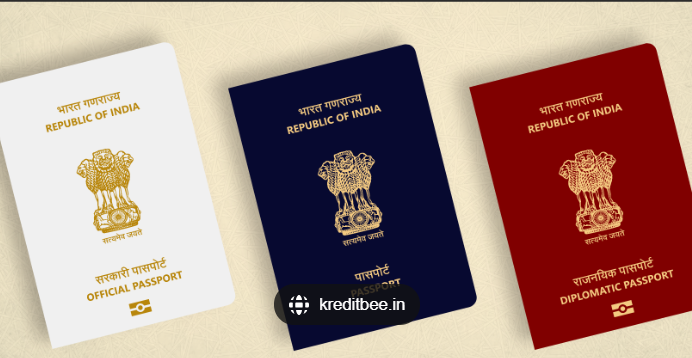You might be wondering, “Does the colour of my passport actually change anything?” On the face of it, a passport is just a travel document. But for many Indians like salaried employees like Ravi, parents planning a family holiday, and small business owners travelling for trade, the passport colour (and more broadly, passport strength) affects visa processing time, visa fees, insurance claims, and sometimes even investment or banking choices abroad. Let’s break it down the simple way.
The Four Colors That Define Your Travel Status
India currently issues passports in four distinct colors:
dark blue (ordinary), white (official), maroon/red (diplomatic), and the now-discontinued orange (ECR category). Each color serves a specific purpose and grants different levels of access and privileges during international travel.
Blue Passport: The Common Man’s Gateway
The dark blue passport, officially called the Ordinary Passport or Type P passport, is what 99% of Indians carry. This is issued to regular citizens for personal travel, business trips, education abroad, or leisure tourism. Whether you’re Priya planning her honeymoon in Europe or Vikash attending a business conference in Singapore, this blue passport gets the job done.
Key features of the blue passport:
- Valid for 10 years for adults, 5 years for minors
- Available in 36-page or 60-page formats
- Now issued as e-passports with embedded chips for enhanced security
- Used by over 92 million Indians as of 2024
White Passport: The Government Official’s Privilege
The white passport is exclusively for Indian government officials traveling abroad on official business. Think IAS officers, IPS officials, and other civil servants representing India internationally. Suresh, an IAS officer who frequently travels for diplomatic missions, explains that his white passport ensures faster immigration clearance and special treatment at international airports.
Benefits of white passports:
- Expedited immigration processing
- Special privileges at international borders
- Recognition as official government representatives
- Enhanced diplomatic courtesy
Maroon Passport: The Elite Diplomatic Circle
The maroon or red passport represents the highest level of travel privilege in India. Reserved for diplomats, senior government officials like ministers, Members of Parliament, and Indian Foreign Service officers, this passport comes with extraordinary benefits.
Dr. Sharma, a former Indian ambassador, shares that his maroon passport granted him:
- Special lounges and facilities at airports
- Diplomatic immunity in many countries
- Visa-free access to numerous nations
- Priority treatment at all international borders
Orange Passport: The Controversial Chapter That Never Was
Here’s where things get interesting. In 2018, the Indian government announced plans for orange passports for citizens requiring Emigration Check Required (ECR) status – typically those without Class 10 education. The idea was to protect less-educated Indian workers from exploitation abroad, particularly in Gulf countries where many Indians work in construction and domestic help.
However, this decision sparked massive controversy. Critics, including Congress leader Rahul Gandhi, argued it would create a two-tier system discriminating against India’s working class. The Kerala High Court received petitions challenging this move, calling it discriminatory.
After widespread protests and representations, External Affairs Minister Sushma Swaraj reversed the decision in January 2018. The orange passport was officially scrapped before it could be implemented, ensuring all Indian citizens retain the dignity of uniform passport colors.
Understanding ECR vs Non-ECR: What It Means for You
Even though orange passports were never issued, the ECR (Emigration Check Required) system still exists. If you don’t have a Class 10 certificate, your blue passport will have an ECR stamp, requiring emigration clearance before traveling to 18 specific countries including UAE, Saudi Arabia, Qatar, and Kuwait for employment.
Ravi, a construction worker from Uttar Pradesh, explains: “I needed special clearance from the Protector of Emigrants office before joining a construction company in Dubai. The ECR stamp in my passport meant extra paperwork, but it also ensured my job contract was verified and legitimate.”
Non-ECR passport holders (those with Class 10 or higher education) can travel freely without such clearances.
The Application Process: Getting Your Right-Colored Passport
For most Indians, applying for a blue passport through the Passport Seva portal is straightforward. You select your Regional Passport Office (RPO) based on your location, book an appointment at a Passport Seva Kendra (PSK), and submit required documents including Aadhaar, address proof, and birth certificate.
The annual statistics show the system’s reach: over 13 million passports were issued in 2023 alone, the highest in recorded history. The pandemic year 2020 saw the lowest issuance, highlighting how global events impact travel document needs.
White and maroon passports require special authorization through government channels, with applications processed through the Ministry of External Affairs rather than regular RPOs.
Frequently Asked Questions
Q: Can I change my passport color if I get a government job?
A: Yes, government officials can apply for white passports when traveling on official business, but they typically retain their blue passports for personal travel.
Q: Is the orange passport completely discontinued?
A: Yes, the orange passport plan was officially scrapped in January 2018 and will never be implemented.
Q: Do diplomatic passport holders pay fees?
A: No, diplomatic passports are issued free of charge as they’re exclusively for official government duties.
Q: How long does it take to get a diplomatic passport?
A: Diplomatic passports are processed much faster, typically within 3-5 days compared to regular passports.
Q: Can ECR passport holders travel anywhere?
A: Yes, but they need emigration clearance when traveling to 18 specific countries for employment.
The Bottom Line
Your passport color might seem like a minor detail, but it carries significant meaning in India’s complex travel ecosystem. Whether you’re carrying the common blue passport or aspiring for diplomatic maroon, understanding these distinctions helps you navigate international travel more effectively.
